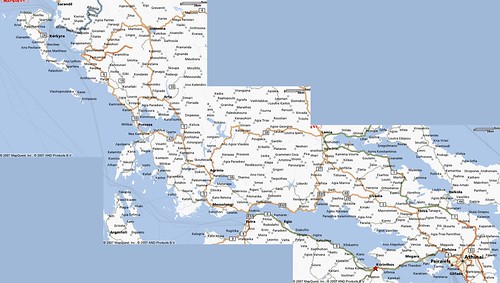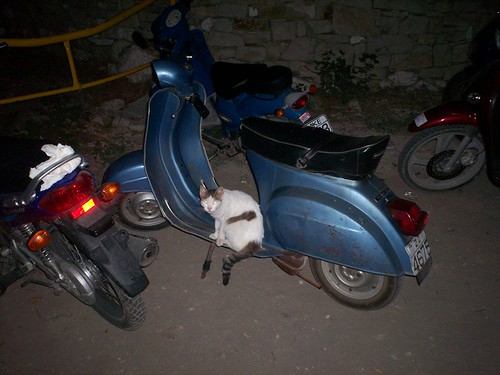 For my vacation to Kerkyra, I decided to use my Vespa and not the car, since the latter makes me feel "encased". I use my car on very few occasions, such as `rainy days, cold days (below 2-3 C) or heatwaves (above 40 C) or when I needing to carry something heavy or bulky. Despite having already been once to Kerkyra on my Vespa, I decided this year to travel all the way along the coast of western Greece, instead of getting on the ferry in Patra that would take me directly there, fresh and safe. This would add another 280 km to the Vespa 's odometer in just a single trip.
For my vacation to Kerkyra, I decided to use my Vespa and not the car, since the latter makes me feel "encased". I use my car on very few occasions, such as `rainy days, cold days (below 2-3 C) or heatwaves (above 40 C) or when I needing to carry something heavy or bulky. Despite having already been once to Kerkyra on my Vespa, I decided this year to travel all the way along the coast of western Greece, instead of getting on the ferry in Patra that would take me directly there, fresh and safe. This would add another 280 km to the Vespa 's odometer in just a single trip. Travelling on a scooter long distance, specially when the engine has small displacement, is not some difficult task to achieve, but certain aspects have to be considered: Trying to cross the country from one end to another on a scooter may sound like madness and scary, but things are not as dramatic as one could think. There are some serious reasons (at least for me) to do so: how does it looks like; having such an experience; how are your feelings while being on the road. And many more.
Travelling on a scooter long distance, specially when the engine has small displacement, is not some difficult task to achieve, but certain aspects have to be considered: Trying to cross the country from one end to another on a scooter may sound like madness and scary, but things are not as dramatic as one could think. There are some serious reasons (at least for me) to do so: how does it looks like; having such an experience; how are your feelings while being on the road. And many more.It is rather a matter of psychology, a mind game. But before doing so, it must be clear in your mind t that you are ready for anything, that you may not get what you expect.
 Be sure of what you want to do. You need to prioritize things in your mind. Of the highest priority is the availability of time. Travelling for such a long time will consume at least a day, if everything proceeds smoothly.
Be sure of what you want to do. You need to prioritize things in your mind. Of the highest priority is the availability of time. Travelling for such a long time will consume at least a day, if everything proceeds smoothly.You must get used to the constraints of being on a vehicle in which everything is contained in a space a bit wider than your body: your clothes, personal items, cameras, books, tools, etc. Your personal space lies between the handlebars and saddle.
Then, there’s the equipment. Get used to the idea of wearing a helmet and a motorbike jacket for many hours, without multizone automatic air conditioning, ABS+TCS, refreshment fridge, GPS navigation, frappe holder, mp3 player for you and DVD players for the children in back. At a minimum, you must protect your body against a fall that could otherwise land you in the local Health Centre with burns caused by being dragged on the tarmac. Plus the blazing sun takes its toll after hours of exposure. I have only a winter jacket, causing me to sweat constantly in 35-40 C heat, even in the shade; I hope next year to buy a summer one. And even though temperatures don't fall below 22-23C at night, it can get chilly on a bike, so the heavier jacket pays off.
 Also be aware of the capabilities of your vehicle. You are on a race of endurance. A scooter has neither capabilities for speeding, nor travelling hundreds of kilometers in a single day. Besides that, it is not designed for travelling at maximum speed for hours. By keeping a constant eye on the tachymeter, you will need to define an average speed, and for sure not approach the maximum overall speed. For instance, my Vespa, has a maximum speed of 102km/h. For most of the journey, I kept an average speed of 70 km/h with a maximum average speed of 80 km/h; and when I was in a hurry, the average speed increased to 85 km/h, trying to catch the last ferry to Kerkyra.
Also be aware of the capabilities of your vehicle. You are on a race of endurance. A scooter has neither capabilities for speeding, nor travelling hundreds of kilometers in a single day. Besides that, it is not designed for travelling at maximum speed for hours. By keeping a constant eye on the tachymeter, you will need to define an average speed, and for sure not approach the maximum overall speed. For instance, my Vespa, has a maximum speed of 102km/h. For most of the journey, I kept an average speed of 70 km/h with a maximum average speed of 80 km/h; and when I was in a hurry, the average speed increased to 85 km/h, trying to catch the last ferry to Kerkyra. Always choose secondary, provincial roads. It is safer for a slow-moving motorbike. One of the main reasons for an accident between two vehicles is a big speed difference between them. Plus, you can see things such as scenery and landscape that would otherwise be neglected when isolated in a passenger cab.
Always choose secondary, provincial roads. It is safer for a slow-moving motorbike. One of the main reasons for an accident between two vehicles is a big speed difference between them. Plus, you can see things such as scenery and landscape that would otherwise be neglected when isolated in a passenger cab.Remember, realistically speaking, problems will develop due tostraining a scooter on a trip far beyond its usual operational range and continuous use. It is much like us human beings, working around the clock for several weeks, months or years with very little rest. Having a minor mechanical problem while far from the repair shop might easily develop into a major one, and consequently set off a chain of events. This could lead to a major damage and possibly rendering your vehicle immobile, possibly in an isolated area of wilderness, where road assistance (or any assistance at all) is very far away. After the loss of tachymeter indicators while still in Paxi, I had no way to check the average speed, thus pressing the Vespa for longer periods at a speed that was not very clear, but nonetheless intense. At about 10 kilometers before the Rio-Antirrio bridge, this led to the transmission belt overheating and the transmission spools refusing to release the belt while the engine stood idle. Then the "backup" plan had to be activated. With another 220 kilometers to go, and the nature of damage unknown, I had to keep a low rhythm as I was dreaming of my bed and shelter. So my estimated average speed was not over 30-50 km/h. The trip took a lot longer, but it was worth it.

Trip stats
Total distance covered: 1040 km
travelling days: 2
Markopoulo-Igoumenitsa part
Distance: 520 km
Departure time: 12:45
Arrival time: 21:27
Average speed: 70-75 km/h
Stops: 4
Average time on stops: 4-10 min
Fuel consumed: 15 lt
Failures: none
Route:
Markopoulo, Peania, Athens-centre, Aspropyrgos, Elefsina, Megara, Kinetta, Ag. Theodoroi, Korinthos, Xylokastro, Akrata, Egeira, Diakopto, Egio, Rio, Antirrio, Messologi, Etoliko, Lesini, Astakos, Mytikas, Paleros, Vonitsa, Aktio, Preveza, Igoumenitsa, Kerkyra (ferry)
Igoumenitsa-Markopoulo part
Distance: 520 km
Departure time: 16:25
Arrival time: 04:50
Average speed: 70-75 km/h Igoumenitsa-Antirrio section
30-40 km/h Rio-Markopoulo section
Stops: 8
Average time on stops: 3-60 min
Fuel consumed: 15 lt
Failures: Severed tachymeter wire (Paxi), overheating and wearing of transmission belt drums (Messologi-Antirrio)
Route:
Kerkyra (ferry), Igoumenitsa, Preveza, Aktio, Vonitsa, Mytikas, Paleros, Astakos, Lesini, Etoliko, Messologi, Antirrio, Rio, Egio, Diakopto, Egira, Akrata, Xylokastro, Korinthos, Ag. Theodori, Kinetta, Megara, Elefsina, Aspropyrgos, Athens-centre, Peania,
Markopoulo
Fuel type: 100 oct. unleaded petrol
Oil consumed: 150 ml
Oil type: 10W/40
Scooter: Piaggio Vespa ET4, mod.'97
Engine: 125 cc, 4-stroke, air cooled,
electric/cick starter
Odometer: 40329 km
